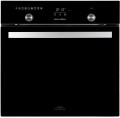Capacity
The working capacity of the oven. The amount of food that can be cooked in the device and the amount of space required for embedding depends on this parameter.
A capacity of about 50 – 60 litres is considered quite sufficient for a family of 2 – 3 people. It is the capacity that most modern built-in ovens have. However, there are other options — modest models of 20 – 30 litres, similar in capacity to microwave ovens,
large in capacity for home baking and large cabinets of 100 litres or more, designed more for cafes and restaurants than for home use.
Cooking temperature
The cooking temperature range allows you to understand which special tasks are subject to the oven. The lower temperature from which the oven starts heating, usually, is in the range of +30 to +50 ˚C. So, for example, the minimum heating temperature at
+30 ˚C allows you to defrost products. Models with a minimum of
40 ˚C and
50 ˚C allow you to heat ready meals, heat tableware (before serving), dry crackers, etc.
Guides
Type of guides for installing baking sheets that are used in the oven.
—
Frame. Classic guides have the form of slots with protrusions in the side walls of the oven. This design is simple and inexpensive. However, it is not very convenient — when removing baking sheets, you have to pull your hand into a heated oven, which means you will need a mitten or potholder. And the extraction itself may require effort, especially if the guides are dirty and the trays go tight in them.
—
Telescopic. Retractable guides on which the baking sheet “leaves” the oven, usually, immediately when the door is opened. Such devices are more convenient than frame ones, but they are more expensive and not suitable for all situations (for example, sometimes to check a dish you only need to open the lid without pulling it out). Therefore, in most models,
telescopic guides are only on one level. But
telescopic guides on two levels or even
three levels already classifies the device as a top segment.
Oven cleaning
The type of inner cleaning provided in the oven. Note that pollution has to be removed with a rag or sponge, but modern ovens often provide various tricks that facilitate the process. The options might be:
—
Catalytic. A special wall coating is used in ovens with this cleaning method: it breaks down fats and other stubborn dirt into constituent elements that can be easily removed. The effectiveness of such a coating decreases over time, but it is enough for at least several years of full use. It should be noted that the catalytic coating can be implemented by applying it to special removable plates that are installed on the back or side walls of the oven chamber.
—
Steam cleaning. Cleaning with hot steam, which softens dried-on dirt and partially breaks down fats. In some models, there is a built-in steam generator for this, in others it is enough to put a container of water in the working chamber and turn on the cleaning program.
—
Pyrolytic. Cleaning by heating the chamber to a very high temperature — about 500 ° C. At this temperature, most of the contaminants are incinerated into ash, which can then be easily removed. Pyrolytic cleaning is considered the most effective, but ovens with this function are expensive, time consuming, require significant electricity/gas consumption, and can lead to unpleasant odors.
Energy class
This indicator characterizes how economically the oven consumes electricity. Initially, classes were marked in Latin letters from
A(highest) and further down as they went down. Later improved classes
A +,
A ++, etc. appeared (the more pluses, the better). More energy-efficient models are more expensive but can pay for themselves in the process of use, especially if you have to cook often and in large quantities.
Connected load
The electrical power consumed by the oven during operation, in other words, the power that must be supplied to the oven so that it can work normally. This parameter determines not only the total energy consumption (and, accordingly, the amount of electricity bills) but also the specifics of the power supply: with a power consumption of several kilowatts, a conventional outlet may not be suitable, and the wiring must be quite reliable.
Note that it is customary to indicate the connection power only for electric models (see "Oven"), as well as for gas devices with electric grills.
Dimensions (HxWxD)
In the case of ovens, the dimensions determine not only the sizes, but also the conditional form factor and the possibility of installing models. Dividing by height, the devices can be
compact(low) for installation in hanging cabinets and
full-sized — classic ovens for installation under the countertop. As for the width, in addition to
standard models of 60 cm, there are
narrow (45 cm) and
wide (90 cm) models to interact with similar wide hobs.

